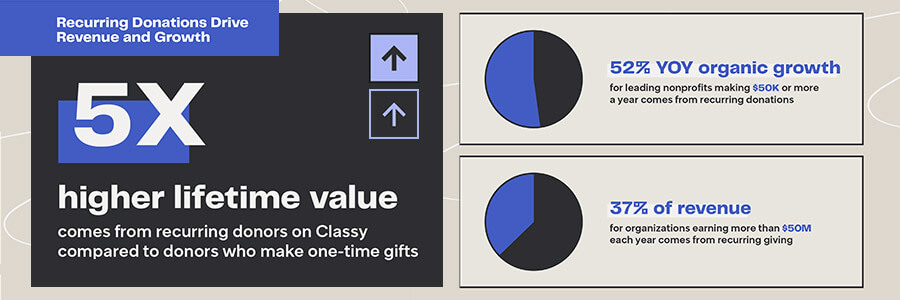You Can’t Just Set It and Forget It.
Tips for a Monthly Recurring Stewardship Program.
Many nonprofit development teams invest resources and focus on acquiring monthly recurring donors and rightly so because monthly donors are reliable, valuable, and provide monthly revenue organizations can count on, even during the most challenging fundraising slumps. Now that you’ve acquired these recurring donors, how should you go about retaining them?
The following research from Classy, found that 52% of organic growth in donations at organizations raising $50,000 or more annually came from recurring givers. At the largest organizations — $50 million or more raised annually — 37% of total revenue came from recurring gifts.
Recurring donors are top prospects for bequests securing key long-term revenue in the future. They care enough to give monthly — why wouldn’t they care enough to include you in their estate plans?
But once you have converted one-time donors to give monthly you can’t just set it and forget it.
Leaving your monthly program to run on autopilot could put your organization’s revenue and donor retention at risk.
The foundation to a successful monthly giving program is one that is built on the guiding principle of making donors feel engaged and appreciated. And that’s where stewardship comes in.
Monthly donors are some of your most loyal supporters, so it is in your organization’s best interests to have a stewardship strategy to ensure that you are retaining these very valuable donors as well as securing critical revenue for your organization in both the short and long-term.
To avoid falling asleep at the wheel of your monthly recurring giving program, here are some key components of a monthly recurring donor stewardship program:
1. First and foremost, thank and acknowledge monthly givers’ generosity and do it often.
Believe it or not, donors want to hear from you after making the switch to monthly. I have seen some groups use reduced communications and less mail as an incentive to converting to monthly giving. Donors who commit monthly care deeply about the organization’s mission and not regularly communicating with them is a mistake.
2. Invest in having someone on staff serve as a dedicated monthly donor contact.
This person would provide “concierge” services as a monthly donor steward or coordinator with a dedicated phone number and email address.
3. Report back on the impact donors’ gifts make for your organization.
A great way to show impact is through personal stories, mini-proposals or progress reports with infographics, photos, or videos as part of a communications strategy tailored to monthly recurring donors.
4. Regularly engage and treat recurring donors as stakeholders within the organization so they are persuaded to stay active.
Be sure to send cultivations around holidays, birthdays, and anniversaries. Provide opportunities for these donors to give feedback to the organization through surveys and forums as well as inviting them to special in-person and web-based events.
5. Offer opportunities for upgrading:
Either through increasing their monthly pledge amount or making additional one-time gifts to special campaigns.
6. Cultivate for planned giving:
As mentioned earlier, recurring donors are great prospects for bequests because they give multiple gifts over multiple years and therefore are some of your organization’s most loyal and committed donors.
As nonprofits continue to navigate a challenging fundraising environment it is more important than ever to focus on acquiring monthly recurring donors but they also need to invest in retaining them by building relationships and making monthly giving as easy as possible.
Did you enjoy reading this article? Having a Pre-lapsed Strategy Matters and Navigating the USPS Postal Increase with a Wink and a Smile are other fundraising strategy articles written by the IDM Team that we know you’ll love!


